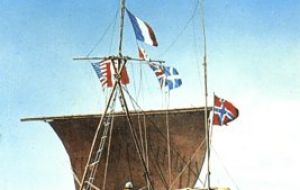MercoPress. South Atlantic News Agency
Norwegian Kon-Tiki expedition ‘partly right’ about Easter Island-Bolivia links
 The 1947 expedition took 101 days to reach Easter Island from South America
The 1947 expedition took 101 days to reach Easter Island from South America A new study has found that a Norwegian, who undertook a Kon-Tiki expedition to prove that Polynesians had South American roots, was partly right about his theory.
In 1947, late Thor Heyerdahl controversially claimed that Easter Island's famous statues were similar to those at Lake Titicaca in Bolivia.
And to prove his point, he sailed on his Kon-Tiki, a balsa wood raft, for 4,300 miles from Peru to French Polynesia to show that it could have been colonised from South America rather than Asia as commonly thought.
But despite completing the voyage in 101 days, and surviving on sharks caught with his bare hands, the Norwegian failed to sway the scientific community. Now, 64-years later, new research has finally proved the adventurer was at least partly right after all.
A team of scientists have tested the genetic make up of descendants of the original islanders and found it includes DNA that could have only come from Native Americans.
That means that some time before the remote islands, including Easter Island, were colonised by Europeans the locals had interbred with people from South America.
Now Professor Erik Thorsby of the University of Oslo in Norway has found clear evidence to support elements of Heyerdahl's hypothesis.
In 1971 and 2008 he collected blood samples from Easter Islanders whose ancestors had not interbred with Europeans and other visitors to the island.
Thorsby looked at the genes, which vary greatly from person to person, and found most of the islanders' genes were Polynesian, but a few of them also carried genes only previously found in indigenous American populations.
Thorsby found that in some cases the Polynesian and American genes were shuffled together, the result of a process known “recombination”. This means the American genes would need to be around for a certain amount of time for it to happen.
Thorsby can't put a precise date on it, but says it is likely that Americans reached Easter Island before it was “discovered” by Europeans in 1722. However, Thorsby said that his new evidence does not confirm Heyerdahl's theory that the islanders were originally all from South America.
The first settlers to Polynesia came from Asia, and they made the biggest contribution to the population, he said.
“Heyerdahl was wrong but not completely”. The work was presented at a Royal Society talk in London and reported in the New Scientist. (ANI)




Top Comments
Disclaimer & comment rulesCommenting for this story is now closed.
If you have a Facebook account, become a fan and comment on our Facebook Page!